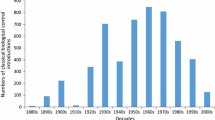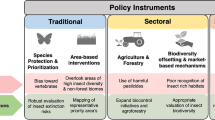Abstract
Climate change creates opportunities and constraints for imported biological control agents, target pests, and non-target prey to modify their geographic distributions. However, predictions about how climate change will affect distributions of natural enemies and their hosts/prey cannot be made at present because of insufficient data about how species will respond to climate change, both directly and indirectly. Factors underlying the responses include tolerance to physical changes in the environment, dispersal ability, geography, and habitat requirements. Despite the limitations for making predictions, a review of the literature for imported generalist natural enemies indicates that climate change will result in range expansions or range shifts in some species, and that these changes are likely to increase non-target risks as well as influence the effectiveness of biological control programs. To better guide future decisions concerning importation biological control, additional field studies, experiments, and theoretical models are needed. Recommended actions include conducting surveys for non-target species in areas undergoing climate change, determining tolerances to changes in temperature and precipitation for natural enemies and hosts/prey, incorporating climate data into insect population models, and long-term assessments to document the impact of climate change on non-target species and efficacy of biological control programs. Because climate change will impact both target pests and non-target species, the work will be best-accomplished by grant-funded programs involving interdisciplinary teams of scientists.


Similar content being viewed by others
References
Backlund P, Janetos A, Schimel D (2008) The effects of climate change on agriculture, land resources, water resources, and biodiversity in the United States. In: Land resources, water resources, and biodiversity in the United States. Synthesis and assessment product 4.3 report by the U.S. climate change science program and the subcommittee on global change research
Balciunas JK, Coombs E (2004) International code of best practices for biological control of weeds. In: Coombs EM (ed) Biological control of invasive plants in the United States, 1st edn. Oregon State University Press, Corvallis OR, pp 130–136
Bässler C, Hothorn T, Brandl R, Müller J (2013) Insects overshoot the expected upslope shift caused by climate warming. PLoS ONE 8(6):e65842
Berg MP, Kiers ET, Driessen G, van der Heijden M, Kooi BW, Kuenen F, Liefting M, Verhoef HA, Ellers J (2010) Adapt or disperse: understanding species persistence in a changing world. Glob Change Biol 16:587–598
Brown PMJ, Thomas CE, Lombaert E, Jeffries DL, Estaup A, Lawson Handley L-J (2011) The global spread of Harmonia axyridis (Coleoptera: Coccinellidae): distribution, dispersal and routes of invasion. BioControl 56:623–641
Burrows MT, Schoeman DS, Buckley LB, Moore P, Poloczanska ES, Brander KM, Brown C, Bruno JF, Duarte CM, Halpern BS, Holding J, Kappel CV, Kiessling W, O’Connor MI, Pandolfi JM, Parmesan C, Schwing FB, Sydeman WJ, Richardson AJ (2011) The pace of shifting climates in marine and terrestrial ecosystems. Science 334:652–655
Carroll AL, Taylor SW, Regniere J, Safranyik L (2003) Effect of climate change on range expansion by the mountain pine beetle in British Columbia. The bark beetles, fuels, and fire bibliography. Paper 195. https://digitalcommons.usu.edu/barkbeetles/195. Accessed 04 July 2020
Collinge SK (2009) Ecology of fragmented landscapes. The Johns Hopkins University Press, Baltimore MD
Crozier L (2004) Warmer winters drive butterfly range expansion by increasing survivorship. Ecology 85:231–241
Davis MB, Shaw RG (2001) Range shifts and adaptive responses to Quaternary climate change. Science 292(5517):673–679
Delfosse ES (2005) Risk and ethics in biological control. Biol Control 35:319–329
Deutsch CA, Tewksbury JJ, Huey RB, Sheldon KS, Ghalambor CK, Haak DC, Martin PR (2008) Impact of climate warming on terrestrial ectotherms across latitude. PNAS 105:6668–6672
Easterling DR, Meehl GA, Parmesan C, Changnon SA, Karl TR, Mearns LO (2000) Climate extremes: observations, modeling, and impacts. Science 289:2068–2074
Edwards JG (1957) Entomology above timberline: II. the attraction of ladybird beetles to mountain tops. Coleopterists Bulletin 46:142–143
Eigenbrode SD, Davis TS, Crowder DW (2015) Climate change and biological control in agricultural systems: principles and examples from North America. In: Björkman C, Niemelä P (eds) Climate change and insect pests. CAB International, Boston MA, pp 119–135
Evans EW, Carlile NR, Innes MB, Pitigala N (2013) Warm springs reduce parasitism of the cereal leaf beetle through phenological mismatch. J Appl Entomol 137:383–391
Evans EW, Soares AO, Yasuda H (2011) Invasions by ladybugs, ladybirds, and other predatory beetles. BioControl 56:597–611
Grez AA, Zaviezo T, Roy HE, Brown PMJ, Bizama G (2017) Rapid spread of Harmonia axyridis in Chile and its effects on local coccinellid biodiversity. Divers Distrib 22:982–994
Hodek I (2012) Diapause/dormancy. In: Hodek I, van Emden HF, Honĕk A (eds) Ecology and behavior of the ladybird beetles (Coccinellidae). Blackwell, London, pp 275–342
Hodkinson ID (2005) Terrestrial insects along elevation gradients: species and community responses to altitude. Biol Rev 80:489–513
Honĕk A, Dixon AFG, Soares AO, Skuhrovec J, Martinkova Z (2017) Spatial and temporal changes in abundance and composition of ladybird (Coleoptera: Coccinellidae) communities. Curr Opin Insect Sci 20:61–67
Jeffries DL, Chapman J, Roy HE, Humphries S, Harrington R, Brown PMJ, Lawson Handley L-J (2013) Characteristics and drivers of high-altitude ladybird flight: insights from vertical-looking entomological radar. PLoS ONE 8(12):e82278
Kauffman WC, Nechols, JR (1992) Selection criteria and ecological consequences of importing natural enemies. Proceedings Thomas Say Publications in Entomology. Entomological Society of America, Lanham, MD
Kawakami Y, Yamazaki K (2017) Disappearance of summer collection records for Menochilus sexmaculatus (Coleoptera: Coccinellidae) during climate warming. J Nat History 51(17–18):1015–1020
Knowlton JL, Graham CH (2010) Using behavioral landscape ecology to predict species’ responses to land-use and climate change. Biol Cons 143:1342–1354
Laws A (2017) Climate change effects on predator-prey interactions. Curr Opin Insect Sci 23:28–34
Lu X, Siemann E, He M, Wei H, Shao X, Ding J (2015) Climate warming increases biological control agent impact on a non-target species. Ecol Lett 18:48–56
McCorquodale DB (1998) Adventive lady beetles (Coleoptera: Coccinellidae) in eastern Nova Scotia. Can Entomol News 109:15–20
Merrill RM, Gutiérrez D, Lewis OT, Gutiérrez J, Díez SB, Wilson RJ (2008) Combined effects of climate and biotic interactions on the elevational range of a phytophagous insect. J Anim Ecol 77:145–155
Orme AR (2007) Tectonism, climate, and landscape change. In: Veblen TT, Young KR, Orme AR (eds) The physical geography of South America. Oxford University Press, New York, pp 23–44
Parmesan C, Ryrholm N, Stefanescu C, Hill JK, Thomas CD, Descimon H, Huntley B, Kaila L, Kullberg J, Tammaru T, Tennent WJ, Thomas JA, Warren M (1999) Poleward shifts in geographical ranges of butterfly species associated with regional warming. Nature 399:579–583
Paula DP, Togni PHB, Costa VA, Souza LM, Sousa AATC, Tostes GM, Pires CSS, Andow DA (2020) Scrutinizing the enemy release hypothesis: population effects of parasitoids on Harmonia axyridis and local host coccinellids in Brazil. BioControl (in press)
Rasmann S, Pellissier L, Defossez E, Jactel H, Kunstler G (2014) Climate-driven change in plant-insect interactions along elevation gradients. Funct Ecol 28:46–54
Reznik SY, Dolgovskaya MY, Ovchinnikov AN, Belyakova NA (2015) Weak photoperiodic response facilitates the biological invasion of the harlequin ladybird Harmonia axyridis (Pallas) (Coleoptera: Coccinellidae). J Appl Entomol 139:241–249
Rice ME (1992) High altitude occurrence and westward expansion of the seven-spotted lady beetle, Coccinella septempunctata (Coleoptera: Coccinellidae) in the Rocky Mountains. Coleopt Bull 46:142–143
Roy HE, Majerus ME (2010) Coccinellids in a changing world. In: Kindlmann P, Dixon A, Michaud J (eds) Aphid biodiversity under environmental change. Springer, Dordrecht, pp 149–170
Roy HE, Brown PMJ, Adriaens T, Berkvens N, Borges I, Clusella-Trullas S, Comont RF, De Clercq P, Eschen R, Estoup A, Evans EW, Facon B, Gardiner MM, Gil A, Grez AA, Guillemaud T, Haelewaters D, Herz A, Honek A, Howe AG, Hui C, Hutchison WD, Kenis M, Koch RL, Kulfan J, Lawson Handley L, Lombaert E, Loomans A, Losey J, Lukashuk AO, Maes D, Magro A, Murray KM, San Martin G, Martinkova Z, Minnaar IA, Nedved O, Orlova-Bienkowskaja MJ, Osawa N, Rabitsch W, Ravn HP, Rondoni G, Rorke SL, Sergey K, Ryndevich SK, Saethre M-G, Sloggett JJ, Soares AO, Stals R, Tinsley MC, Vandereycken A, van Wielink P, Viglášová S, Zach P, Zakharov IA, Zaviezo T, Zhao Z (2016) The harlequin ladybird: global perspectives on invasion history and ecology. Biol Invasions 18:997–1044
Samways MJ (1989) Climate diagrams and biological control: an example from the areography of the ladybird Chilocorus nigritus (Fabricius 1798) (Insecta, Coleoptera, Coccinellidae). J Biogeography 16:345–351
Shigesada N, Kawasaki K, Teramoto E (1986) Traveling periodic waves in heterogeneous environments. Theor Popul Biol 30:143–160
Shigesada N, Kawasaki K (1997) Invasion of predators, chap 7. In: Shigesada N, Kawasaki K (eds) Biological invasions: theory and practice. Oxford University Press, New York, pp 133–137
Stijn J, Schreven J, Frago E, Stens A, de Jong PW, van Loon JJA (2017) Contrasting effects of heat pulses on different trophic levels, an experiment with a herbivore-parasitoid model system. PLoS ONE 12(4):e0176704
Stiling PA, Duan JJ (eds) (2000) Nontarget effects of biological control. Kluwer Academic Publishers, New York
Suleman N (2015) Heterodynamic processes in Coccinella septempunctata L. (Coleoptera: Coccinellidae): a mini-review. Entomol Sci 18:141–146
Tauber MJ, Tauber CA, Masaki S (1986) Seasonal adaptations of insects. Oxford University Press, New York
Thompson LJ, Macfadyen S, Hoffmann AA (2010) Predicting effects of climate change on natural enemies of agricultural pests. Biol Control 52:296–306
Turner M, Gardner RH, O’Neill RV (2015) Landscape ecology in theory and practice: pattern and process, 2nd edn. Springer, New York
van Lenteren JC, Bale J, Bigler F, Hokkanen HMT, Loomans AJM (2006) Assessing risks of releasing exotic biological control agents of arthropod pests. Annu Rev Entomol 51:609–634
Walther G-R, Post E, Convey P, Menzel A, Parmesank C, Beebee TJC, Fromentin J-M, Hoegh-Guldberg O, Bairlein F (2002) Ecological responses to recent climate change. Nature 416:389–395
With KA (2019) Essentials of landscape ecology. Oxford University Press, New York
Acknowledgements
I thank David Andow (University of Minnesota) for editorial assistance. I also thank Ted Evans (Utah State University) and John Obrycki (University of Kentucky) for providing reference material.
Funding
No funding sources are associated with this manuscript. The manuscript was not based directly on research I did. Therefore, there were no human participants or animals. Similarly, I have no other conflicts of interest to report. I did receive financial support (travel expenses and per diem), but it was not provided as a part of original research.
Author information
Authors and Affiliations
Corresponding author
Ethics declarations
Conflict of interest
The author declares that there are no conflicts of interest to report.
Additional information
Handling Editor: David Andow.
Rights and permissions
About this article
Cite this article
Nechols, J.R. The potential impact of climate change on non-target risks from imported generalist natural enemies and on biological control. BioControl 66, 37–44 (2021). https://doi.org/10.1007/s10526-020-10032-z
Received:
Accepted:
Published:
Issue Date:
DOI: https://doi.org/10.1007/s10526-020-10032-z




